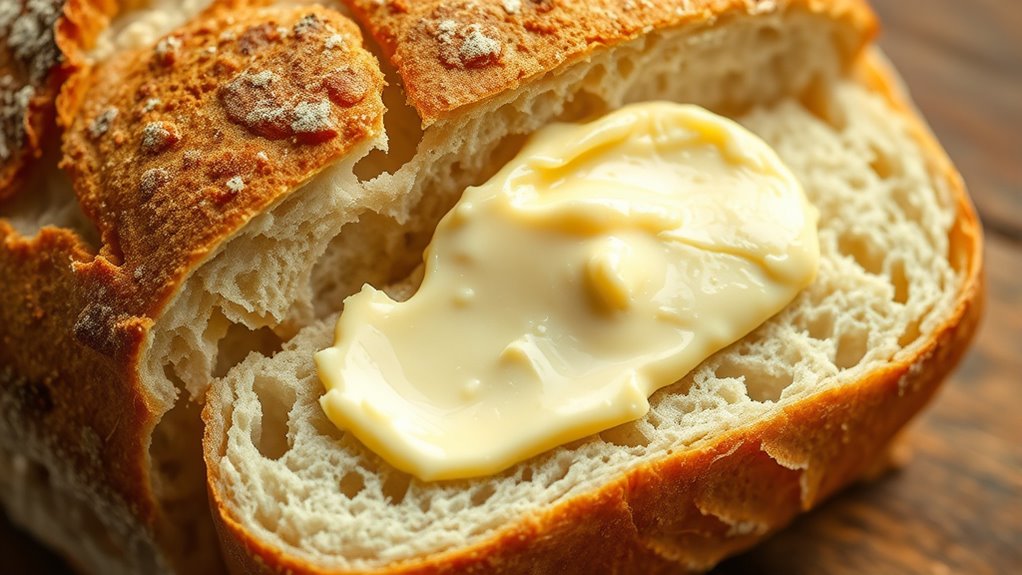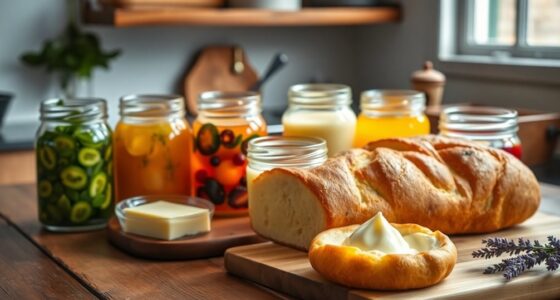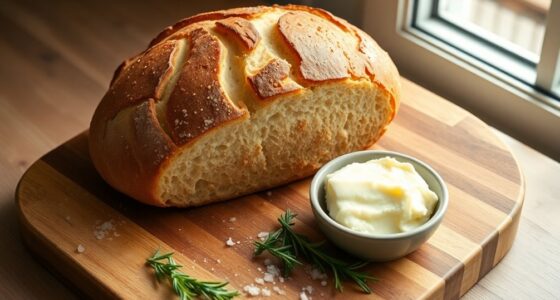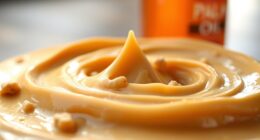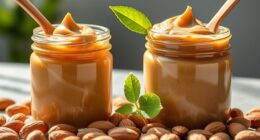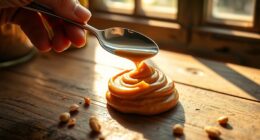To add extra tang to rustic bread, replace part of your butter with whey butter in the dough. Its slight tangy flavor and moisture help create a more complex taste and tender crumb. Adjust your hydration and fat carefully to maintain good gluten development. Proper fermentation and steam during baking will enhance the crust and rise. Want to discover more tips on using whey butter for unforgettable rustic loaves? Keep exploring for all the details.
Key Takeaways
- Substitute part of regular butter with whey butter to introduce subtle tang and enhance flavor complexity.
- Adjust hydration levels slightly higher to compensate for water content in whey butter, ensuring a soft, moist crumb.
- Incorporate complementary sharp cheeses or herbs to amplify the tangy profile of the bread.
- Use longer fermentation times to develop flavor and allow whey butter’s acidity to infuse fully.
- Create steam during baking to develop a glossy crust that balances the tangy flavor with a rustic appearance.
Understanding Whey Butter and Its Unique Characteristics

Whey butter stands out because it’s made from the liquid byproduct of cheese production, giving it a slightly tangy flavor and a softer, creamier texture than traditional butter. Its unique flavor profile adds a subtle acidity that can enhance your rustic bread’s taste. Nutritionally, whey butter offers some benefits, including small amounts of proteins and vitamins from the whey component, making it a slightly healthier choice than regular butter. Its tangy notes can complement the earthy flavors in rustic bread, adding depth and complexity. When you incorporate whey butter, you introduce a nuanced flavor and a smoother texture, which helps create a more interesting and flavorful crust. Additionally, water-based products like whey butter can influence the moisture and texture of baked goods. Overall, understanding whey butter’s characteristics helps you leverage its unique qualities to elevate your bread baking.
Incorporating Whey Butter Into Your Rustic Bread Dough

To incorporate whey butter into your rustic bread dough effectively, start by replacing part of the regular butter or fat with an equal amount of whey butter. This simple swap introduces extra tang and enhances flavor. Experiment with recipe variations to find your favorite balance. Historically, whey butter has been used in traditional bread recipes for its unique properties. Consider this table for ideas:
| Recipe Variation | Notes |
|---|---|
| Classic rustic | 25% whey butter substitution |
| Whole wheat bread | Adds moisture and flavor |
| Sourdough boost | Enhances tanginess |
| Sweet bread | Slightly reduces sweetness |
Incorporating whey butter offers a historical nod to traditional methods while elevating your bread’s taste and texture. Whey butter is recognized for its distinct characteristics, making it a valuable ingredient in baking.
Adjusting Hydration and Fat Content for Optimal Texture
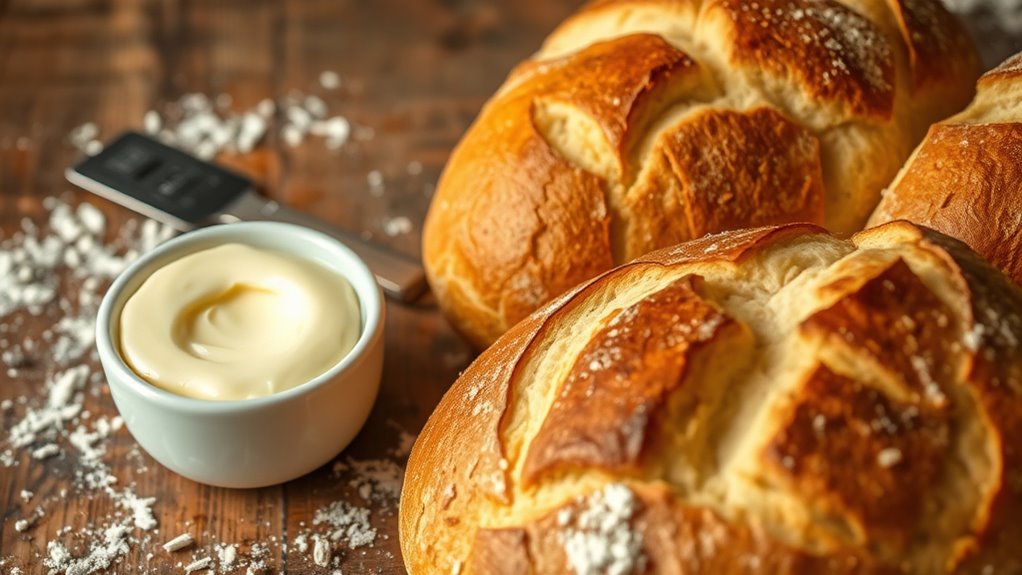
Balancing hydration and fat content is key to achieving the ideal texture in rustic breads with whey butter. Too much liquid can weaken gluten development, resulting in a dense, crumbly loaf, while too little dries out the dough and hampers gluten formation. Adjust hydration carefully—add water gradually until your dough reaches a soft, slightly sticky consistency. Incorporate whey butter gradually, keeping in mind that it adds fat, which can weaken gluten and make dough more tender. Proper dough management is essential for consistent results. Too much fat can lead to a greasy crumb and poor structure, so measure carefully. By fine-tuning hydration and fat levels, you’ll develop dough with the right consistency, ensuring good gluten formation and a balanced, hearty texture in your rustic bread.
Techniques for Achieving the Perfect Rise and Crust
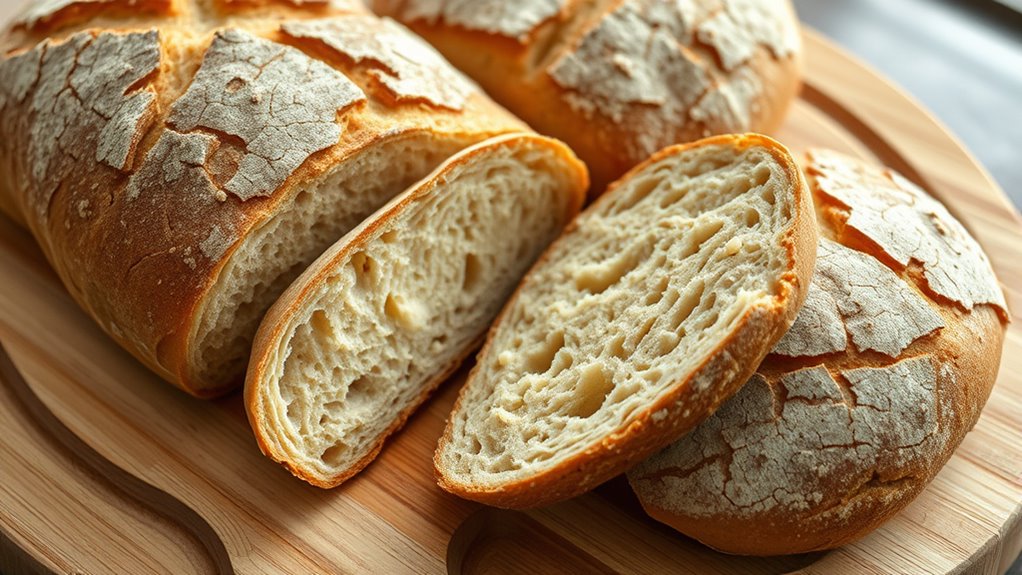
Achieving the perfect rise and crust in rustic bread hinges on mastering fermentation and baking techniques. Proper dough fermentation allows the yeast to develop flavor and gluten structure, resulting in a well-structured rise. To enhance dough fermentation, guarantee your dough ferments long enough at the right temperature, which encourages the development of organic acids that contribute to tanginess. For crust development, steam during the initial baking phase helps create a glossy, crispy exterior. Use a hot oven and consider adding steam by placing a pan of water in your oven or spritzing the dough before baking. This combination of controlled fermentation and strategic baking techniques ensures your bread achieves an airy rise and a beautifully textured, crunchy crust. Incorporating wall organization systems can also help keep your baking space tidy and organized, making the baking process more enjoyable.
Flavor Pairings and Enhancing the Bread’s Tanginess
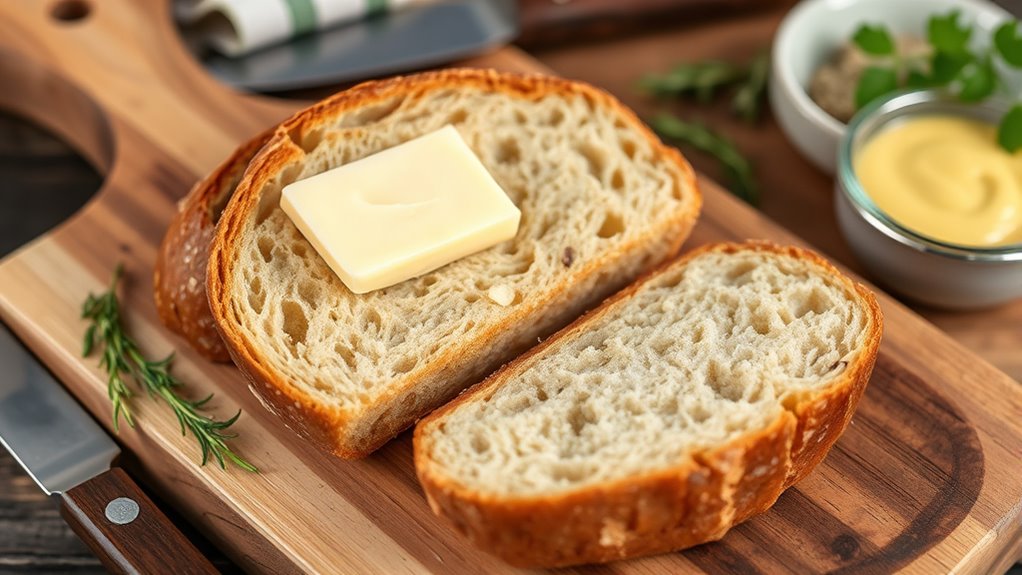
Incorporating complementary flavors can elevate the tanginess of rustic bread, making each bite more complex and satisfying. Cheese pairings are an excellent way to enhance flavor balancing, as sharp cheeses like aged cheddar or tangy goat cheese complement the bread’s acidity. These cheeses add richness while amplifying the bread’s natural tang, creating a harmonious taste. You can also experiment with ingredients like pickles, olives, or fresh herbs to boost flavor complexity. When pairing, think about balancing saltiness, creaminess, and acidity to prevent overpowering the bread’s characteristic tang. The goal is to create a layered tasting experience that highlights the whey butter’s unique qualities while maintaining a well-rounded flavor profile. This approach ensures every slice delivers a memorable, flavorful bite. Additionally, understanding how decluttering can help you organize your kitchen or pantry can make it easier to keep your ingredients fresh and accessible, enhancing your overall cooking experience.
Tips for Storing and Serving Whey-Infused Rustic Breads
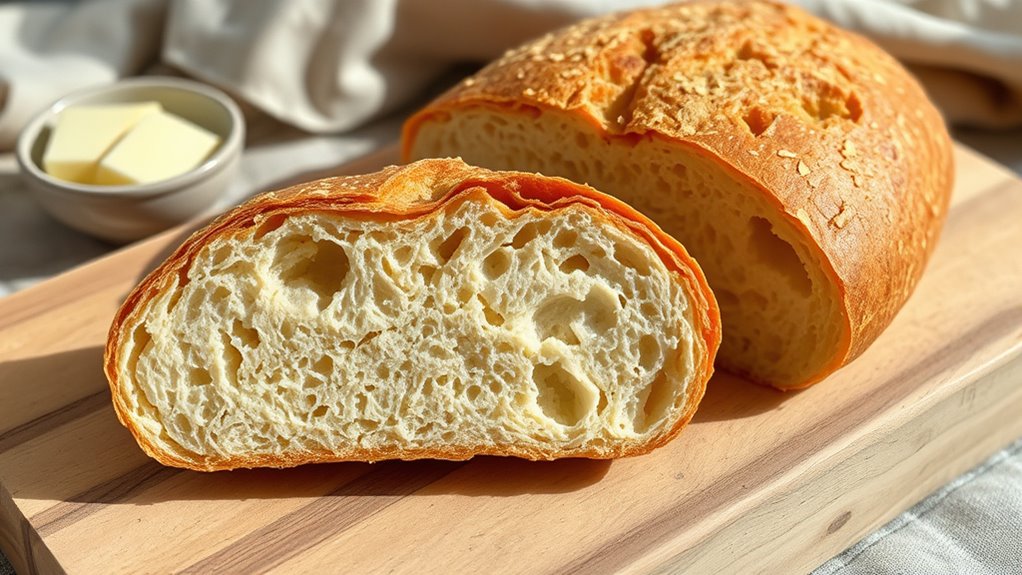
To keep whey-infused rustic bread fresh and flavorful, proper storage is essential. Follow these storage tips to maintain its tang and texture:
- Wrap the bread tightly in parchment paper or a clean kitchen towel to prevent moisture loss.
- Place it in a breathable bread box or paper bag to avoid sogginess.
- For longer storage, freeze slices individually in airtight containers; thaw at room temperature.
- When serving, reheat in a warm oven for a few minutes to revive its crust and aroma.
- Ensuring the correct projector setup and lighting conditions can enhance your viewing experience when enjoying your rustic bread alongside a movie or presentation.
For serving suggestions, slice the bread thickly to showcase its rustic charm, and pair it with cheeses or spreads to enhance the tangy flavor. Proper storage and thoughtful serving will keep your whey-infused bread delicious and satisfying.
Frequently Asked Questions
How Does Whey Butter Affect the Shelf Life of Rustic Bread?
Whey butter can extend your rustic bread’s shelf life by offering preservation benefits. Its natural components help resist mold growth, keeping your bread fresher longer. When you incorporate whey butter, you enhance mold resistance, which slows spoilage and reduces waste. This means your bread stays delicious and safe for more days, giving you more time to enjoy it and less concern about premature mold or staleness.
Can Whey Butter Be Substituted With Other Dairy Fats in Recipes?
You might find it’s a happy coincidence that dairy fat substitutions work well in recipes, giving you flavor variations to explore. When you replace whey butter with other dairy fats like cream or sour cream, you add unique tastes and textures. These substitutions can enhance your rustic bread, offering different tangs and richness. Just keep in mind that each dairy fat brings its own character, so experiment to find what best suits your baking style.
What Are the Best Types of Flours to Pair With Whey Butter?
When choosing flours to pair with whey butter, consider grain combinations that enhance flavor and texture. Opt for bread flours with higher protein content for better gluten development, which works well with whey butter’s tang. Keep flour hydration in mind; using a mix of whole wheat and white flours can balance moisture absorption and give your bread a rustic, hearty crumb. Experiment to find your perfect balance of flavor and structure.
Does Whey Butter Alter the Fermentation Process or Proofing Times?
Did you know that adding fats like whey butter can slow gluten development? When you incorporate whey butter, it can slightly inhibit gluten formation, impacting yeast activity and proofing times. You might notice a longer fermentation process, as the fat coats gluten strands, making them less elastic. However, the effect is usually subtle, so you can adapt proofing times accordingly to ensure your rustic bread achieves the desired rise and texture.
Are There Gluten-Free Alternatives Suitable for Whey Butter Rustic Breads?
You can definitely explore gluten-free flours like rice, almond, or oat flour for rustic breads. Nut-based alternatives, such as cashew or hazelnut butter, also work well and add unique flavors. These options don’t require wheat gluten, so they suit gluten-free diets. Just keep in mind that gluten-free flours may need different hydration levels and binders like xanthan gum to achieve a good texture in your rustic breads.
Conclusion
Now that you know how to incorporate whey butter into your rustic breads, aren’t you enthusiastic to give it a try? Its tangy flavor adds a unique twist that elevates your baking game. With a little experimentation, you’ll discover the perfect balance of texture and taste. So why not embrace this flavorful upgrade and impress everyone with your homemade, whey-infused rustic bread? Your taste buds—and your bread—will thank you!
